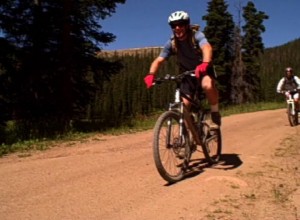Sunday
Featured StoriesMountain Bike Pilgrimage to the Great Stupa
By Joshua Weinstein
The great Tibetan Buddhist teachers say: Bring everything to the path of awakening.
For many years, I tried to do just that with sports. My passion for the outdoors makes me feel awake and alive. Sports provide a way to cultivate wakefulness even when I am unsure how to bring this into the rest of my life.
At a talk in Boulder this spring, I asked Sakyong Mipham Rinpoche if we can use physical exercise to increase our capacity for wakefulness. Here is a partial transcript of our exchange:
Joshua Weinstein: Rinpoche, I heard you say that we can use physical exercise to train our bodies and use meditation to train our minds. And I know that you are both an accomplished meditator and athlete. Could you help me to integrate the ability to train my mind during physical exercise? Is it possible?
Sakyong Mipham: That’s cheating! (Laughter.) Get back on the cushion.
Joshua Weinstein: I was afraid you were going to say that.
Sakyong Mipham: Believe me, if there was another way, I’d be the first one to tell you. Meditation is meditation. Running is running. Exercise is exercise.
When you do meditate, you have a sense of more physicality. When you bring it into your body, we become more attuned. Our mind becomes more attuned to how we feel. That’s a very big benefit if you are a meditator and athlete. Continued below…
A few weeks after I asked the Sakyong that question, I became aware that he has run nine marathons as a fundraiser to rebuild his father’s monastery, Surmang Dutsi Til in eastern Tibet. It dawned on me that this is precisely the way to integrate my passion for sports and the path of meditation.
Out of that inspiration, I am planning a pilgrimage via mountain bike from Boulder to the Great Stupa of Dharmakaya at Shambhala Mountain Center. We will embark on the 166 mile journey on September 25th and plan to reach the Stupa in five days.
I heartily invite anyone inspired by this pilgrimage to join as a rider or support it with a donation.
Sakyong Mipham (continued from above):
With exercise, you know when your mind is paying attention. As your mind pays attention, even if it’s paying attention generally, that’s still an act of training the mind. When you’re exercising and totally thinking about something else, then it’s the same in meditation (when your mind wanders).
From the physiological and psycho-physical point of view, the mind is pervasive throughout the body. Even in tantra, we say that there are thousands of channels in the body and the mind rides on those channels in the form of lung or wind. So in exercise, a lot of the benefit is the controlling of the breathing. And controlling of the breathing accesses the mind.
Environmentally, you can notice when you scatter your energy. If you’re in a confused place like a big mall or subway, where there’s lots of people, your attention and physicality are scattered. And you feel scattered. Whereas if you are focusing in meditation, your attention is really there.
If you are running, you can use the landing of the feet, the posture, and come back to that. That is mind training. There is a natural sense to it. A lot of people feel the benefits from exercise, because at some point in the physical exercise, your mind has to be there.
Especially these days, it’s really important, because there’s a lot of physical stress that we take on. Within the first period of exercise, you burn off the very superficial discursiveness. It feels like cobwebs. Then, you feel more awake and alive. And there is that clarity people experience. Obviously, there is the process of getting into shape, which is usually a slightly painful process. In the same way, in the beginning, meditation is slightly painful, because we are not quite used to it. But as we begin to bring those two together, there is harmony.
So that’s the balance. If exercise is working for you, that’s great. But if you’re also looking for very deep, precise training of the mind, then you have to settle the body. That’s what yoga and lots of different kinds of stretching does, so that you feel comfortable in your body for long enough to focus on your mind.
In the beginning, of course, it’s hard to sit still. But after a while, you get very pliable physically. Then you get mentally pliable. And the depth that you can go in the mind is fantastic. Even sitting here, we notice more. That siren we heard, we might not have even listened to before. Now it captivates us, and that’s just at a very gross level. Then, we go deeper and deeper.
Listen to the rest of Sakyong Mipham Rinpoche’s talk: Equanimity in Uncertain Times.


















Sep 11, 2009
Reply
Nice job. I am signed up to do a bike pilgrimage in Northern California, through an organization called Dharma Wheels and am super excited. Would be great to get it to go through some Shambhala Centers in Northern California on the way, and get some Vajrayana blessings. Glad to be getting them from the Southeast Asian Vipassana folk, and it also happens to be Durga Puja (Hindu holiday) that weekend. Pilgrimage for the Earth is awesome.
I have been doing pilgrimage on my own with my bike to amazing Natural places, and am glad to know of more people organizing things like this. Maybe next year. Biking to Shambhala Mountain Center from Boulder would be pretty amazing. Does it have to be on MTB and have you thought about selling T-shirts?
-ramesh